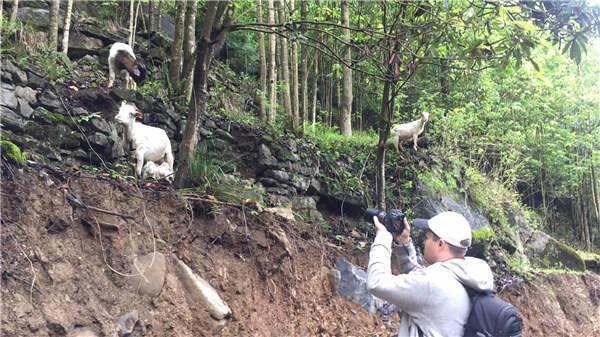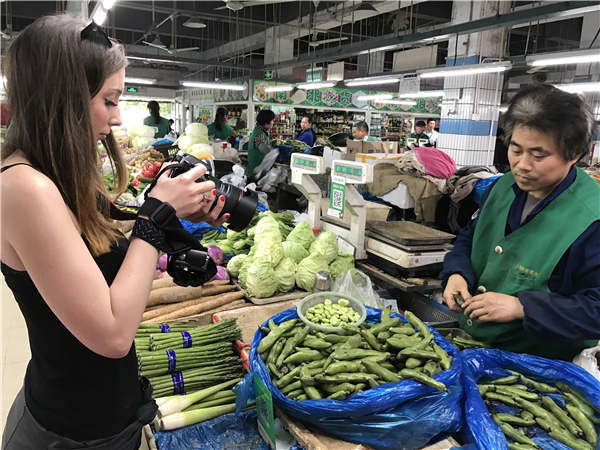编者按:“看中国”项目由北京师范大学中国文化国际传播研究院主办,受到了中国日报的关注和刊载,参加此项目的学生用自己的真实体验和感受传达出了中国的文化韵味,不仅让参与者在文化互动中体味中国文化魅力,而且也在实践中弘扬了中国文化。

Christian Grobbelaar, a young director from South Africa and a participant of the Looking China Project.
[Photo provided to China Daily]
Annual Looking China Youth Film Project has invited filmmakers from around the world to create short documentaries about Chinese culture. Fang Aiqing reports.
A group of young foreign filmmakers are taking an in-depth look at China through their camera lenses. Among them is Christian Grobbelaar, a young director from South Africa, whose short documentary Watch People unveils a remarkable tale of craftsmanship and redemption.
By repairing watches, Li Xin not only managed to fix the problems that lie behind the face of a wristwatch, but he's also fixed many of the problems in his own life as well.
With an array of delicate tools laid out on a blank sheet of paper on his table, the 25-year-old watch repairman begins to demonstrate the process of disassembly, cleaning, oiling and reassembly an art that few people master now while telling the story of the many twists and turns in his life.
After experiencing his parents' divorce, the once well-behaved student fell into bad company and rebelliously turned to a life of smoking, drinking and fighting.
During one particularly fierce fight 10 years ago, Li was stabbed twice. One blow pierced his lung while the other permanently damaged his central nervous system. As a result, he ended up crippled, and was forced to rely on crutches for the rest of his life.
Idling at home for several years, Li's life seemed to be doomed until he found a job at the time-honored Sheng Chang Watch Shop in Xiamen, East China's Fujian province, where traditional watch repair skills are passed on to the disabled.
"When it comes to fixing a watch, you will be faced with a variety of problems. The hardest ones to tackle are the problems you cannot see with your eyes, because they hid very deep. But we still always manage to find a way to fix them," Li says.
Grobbelaar's short documentary applies montage techniques and uses puns in both the title of the work and throughout the story.
As the story "unfolds in an artistic way and combines craftsmanship with humanity", the work was awarded first prize and best artistic presentation at the fourth Golden Lenses awards held recently by Beijing Normal University.
The award aims to reward excellent works from BNU's Looking China Youth Film Project, which annually invites young filmmakers from around the globe to China to experience Chinese culture and, with one-on-one help from a Chinese volunteer, create a 10-minute short documentary about Chinese culture.

Christian Grobbelaar shooting traditional root carving works in Wulong county in Chongqing during the 2018 Looking China Project.
[Photo provided to China Daily]

Grobbelaar shooting his documentary for the project at the Fairy Maiden Mountain in Chongqing.
[Photo provided to China Daily]
Since its launch in 2011, 405 young filmmakers from 49 countries and regions including the United States, United Kingdom, France, Canada and Israel have participated in the project.
By 2017, they had produced 404 short documentaries based on their visits to more than 20 provinces of China and had garnered more than 90 awards in China and abroad, according to Huang Huilin, a professor at BNU who founded the Looking China Project and is director of the Academy for International Communication of Chinese Culture.
In 2017, the focus of the Looking China Project turned to craftsmanship. Foreign participants were asked to shoot documentaries that demonstrated their understanding of Chinese craftsmanship, and to highlight the cultural inheritance and innovation imbued in it.
The Sheng Chang Watch Shop was founded in 1928 and Li's boss, Zhang Xiangjie, 45, is the third generation of owners, who is famous locally for his sense of public spirit.
Zhang's innovative approach to combing business with the public interest has been widely reported in the media, and his desire to pass on his skills to disadvantaged groups rather than keep them in the family.
Several works in the 2017 Looking China Project focused on the types of traditional Chinese craftsmanship that are so familiar that many people take them for granted, while some others looked at the craft traditions that are rapidly vanishing in China's fast-paced society.
By telling these stories from the unique perspective of a young foreign filmmaker, these documentaries are helping to connect Chinese craftsmanship with more universal themes.
One example is the short documentary The Bridge Between Us by Serbian filmmaker Akos K. Kovacs. The film examines the father-son relationship bridged by the traditional Chinese musical instrument of the erhu as its techniques are passed down through the generations.
Immersed in a solo piece of music, the son breaks into a spontaneous smile as he expresses his feelings while playing the erhu.
Yet there was a time in the young man's childhood when he found learning the erhu to be an unbearably tortuous experience.
To escape the laborious process, the son used to record himself playing erhu and often played back the recordings to pretend he was practicing for hours on end. However, his father eventually discovered his trick, and ended up severely punishing him.
The father, who had been working in an erhu factory for 37 years, hoped his son would follow in his footsteps and was not impressed by his son's reluctance to practice.
But it was only after becoming an erhu teacher himself, the son finally realized the importance of cultivating a child's persistence. "Without my father, I wouldn't be the man I am today," he finally admits at the end of the documentary.

Grobbelaar shooting artists creating root carving works in Wulong county during the project.
[Photo provided to China Daily]

Adele Lengyel shooting the making of steamed buns.
[Photo provided to China Daily]
Among the other works, there is a documentary about the revival of traditional carpentry in modern woodwork presented in an accessible format, a warm story about a family that has been making spices for generations and a film covering the extraordinary life of 91-year-old actor Lan Tianye from the Beijing People's Art Theatre.
As Francesco Cardinali, one of the foreign advisers of the Looking China Project and a professor at the University of Macerata in Italy, said during the opening ceremony of the 2018 Looking China Project in April, the project is "not only giving an incredible opportunity to international students, but also, in a broad perspective, the best way to build a strong and healthy relationship between people and countries."
Adele Lengyel, a student from the Budapest Metropolitan University in Hungary, participated in the 2017 project. An avid food lover, the theme for her documentary was in never in any doubt local food, and the making of steamed buns, in particular.
She remembered the first time she stepped into a traditional Chinese market, where culture shock soon turned into real shock.
She was shooting a sequence where fish were being poured into a huge tank where they were held until they were sold.
"I was filming the process when a live fish jumped out of the tank and started writhing on my leg. I screamed because I'd never seen a fish this big, and it was on my leg. Everyone in the market erupted into laughter. What could I do? The fish wanted to be the star of the film," she says.
That day, she was surprised by the large variety of vegetables and strange appearance of the bullfrogs and soft-shelled turtles on offer, and astonished by the sophisticated skills of the fish sellers and encouraged by the smiles on the faces of everyone in the market who clearly enjoyed being on camera.
In Huang's opinion, the Looking China Project is also about intercultural communication.
"There are times when the foreigners and the Chinese volunteers are excited and curious to be working together, and other times they become perplexed and unable to agree on anything. Yet their friendship continues to grow as they learn to cooperate and tolerate each other with the best of intentions," says Huang.
"We discussed the documentary frequently via email before he came to China. Thanks to his detailed shooting plan, things worked out very smoothly," says Huang Xianliang, Grobbelaar's Chinese volunteer.
During the topic discussion on the first day of the project, she wrote a note to Grobbelaar after his presentation, saying "You are the best". Grobbelaar changed the word "you" to "we" and sent it back to her.
According to Huang Huilin, this year's Looking China Project, which is already underway, will involve 100 young foreign filmmakers from 35 countries and regions on a filming relay around 10 provinces and autonomous regions including Guangdong, Hubei, Liaoning, Guizhou, Qinghai and Inner Mongolia. The focus of this year's project is ecological civilization.

Lengyel shooting at a traditional market in Shanghai.
[Photo provided to China Daily]